My 1978 Spider progressive restoration
- RRoller123
- Patron 2020

- Posts: 8179
- Joined: Sun Nov 13, 2011 2:04 pm
- Your car is a: 1980 FI SPIDER 2000
- Location: SAGAMORE BEACH, MA USA
Re: My 1978 Spider progressive restoration
And you have the "emergency trunk opening conversion hole" already in place, as seen in the rear view picture. 
'80 FI Spider 2000
'74 and '79 X1/9 (past)
'75 BMW R75/6
2011 Chevy Malibu (daily driver)
2010 Chevy Silverado 2500HD Ext Cab 4WD/STD BED
2002 Edgewater 175CC 80HP 4-Stroke Yamaha
2003 Jaguar XK8
2003 Jaguar XKR
2021 Jayco 22RB
2019 Bianchi Torino Bicycle
'74 and '79 X1/9 (past)
'75 BMW R75/6
2011 Chevy Malibu (daily driver)
2010 Chevy Silverado 2500HD Ext Cab 4WD/STD BED
2002 Edgewater 175CC 80HP 4-Stroke Yamaha
2003 Jaguar XK8
2003 Jaguar XKR
2021 Jayco 22RB
2019 Bianchi Torino Bicycle
-
Frankd1
- Posts: 135
- Joined: Tue Sep 15, 2015 4:13 pm
- Your car is a: 1978 Spider
- Location: Southwestern Ontario, Canada
Re: My 1978 Spider progressive restoration
I am continuing with pulling the interior so that I can remove the factory floor coating to see what I'm up against as far as floor panel rust.
The driver side seatbelt tensioner is bolted to the floor behind the driver seat, there is a metal bracket that bolts to the vertical portion of the door sill through which the seat belt passes through. The opening in this bracket seems tight because the seatbelt seems to be wearing as it passes through the opening. It could be due to the carpet being thick which pushes the belt up against the top of the opening.. I am going to remove that bracket and clean up the surface rust and repaint.
Is this the original factory mount position for the belt tensioner, driver side: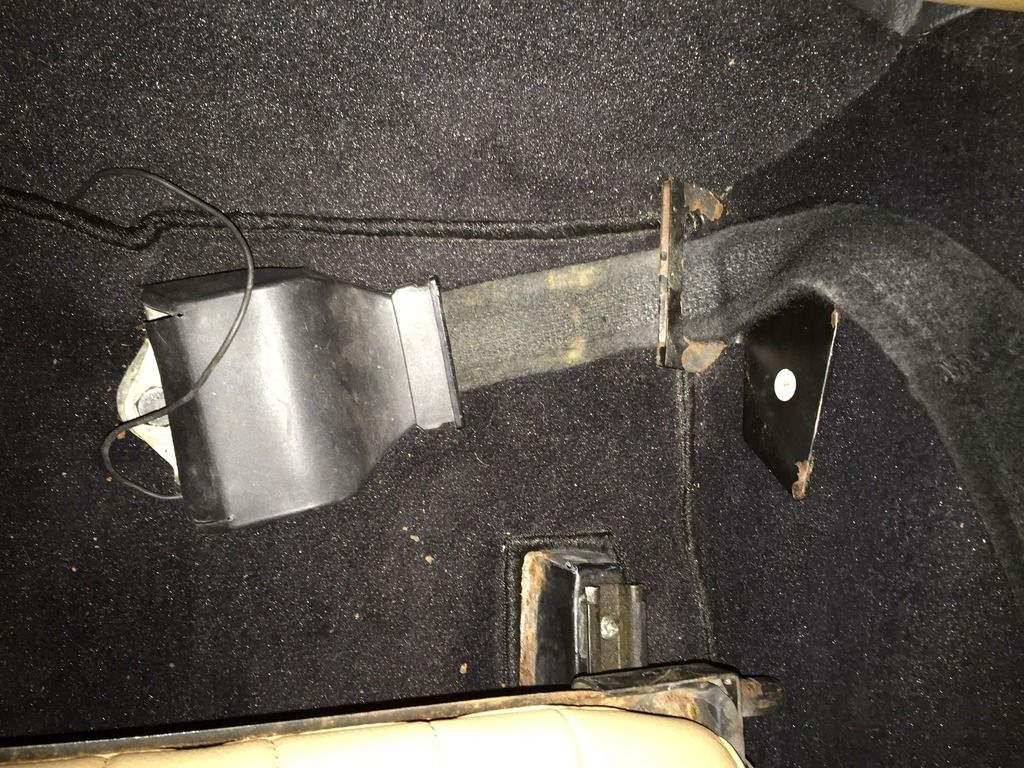
The passenger belt tensioner is also mounted behind the passenger seat but instead of being on the floor, it is mounted to vertical face of the rear seat crossmember:
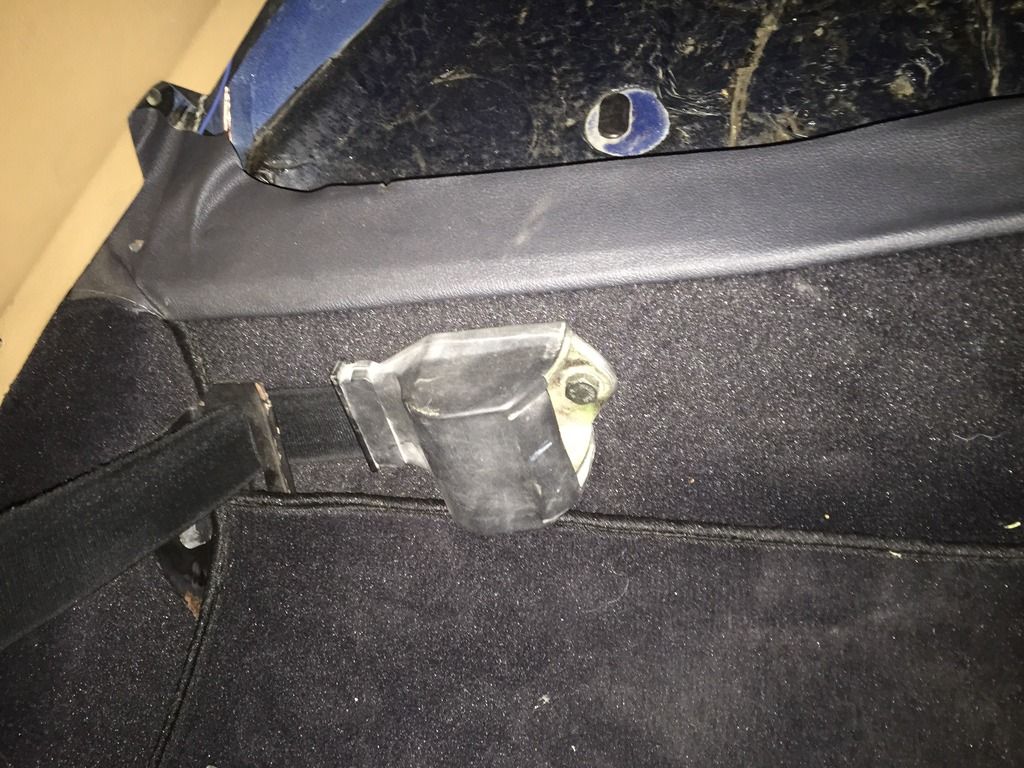
Just want to make sure that these are the original installation points for the belt tensioners.
After I removed the seats I noticed that the nuts in the seat rails seem to float, is this correct?
Here's a quick video of what I mean:
https://www.youtube.com/watch?v=daT5CxNlVko
The driver side seatbelt tensioner is bolted to the floor behind the driver seat, there is a metal bracket that bolts to the vertical portion of the door sill through which the seat belt passes through. The opening in this bracket seems tight because the seatbelt seems to be wearing as it passes through the opening. It could be due to the carpet being thick which pushes the belt up against the top of the opening.. I am going to remove that bracket and clean up the surface rust and repaint.
Is this the original factory mount position for the belt tensioner, driver side:

The passenger belt tensioner is also mounted behind the passenger seat but instead of being on the floor, it is mounted to vertical face of the rear seat crossmember:

Just want to make sure that these are the original installation points for the belt tensioners.
After I removed the seats I noticed that the nuts in the seat rails seem to float, is this correct?
Here's a quick video of what I mean:
https://www.youtube.com/watch?v=daT5CxNlVko
Last edited by Frankd1 on Mon Dec 28, 2015 3:34 pm, edited 2 times in total.
-
Frankd1
- Posts: 135
- Joined: Tue Sep 15, 2015 4:13 pm
- Your car is a: 1978 Spider
- Location: Southwestern Ontario, Canada
Re: My 1978 Spider progressive restoration
Is that the little hole on the rear licence plate valence that is hidden when the plate is installed?RRoller123 wrote:And you have the "emergency trunk opening conversion hole" already in place, as seen in the rear view picture.
-
klweimer
- Posts: 550
- Joined: Tue Mar 27, 2012 7:45 am
- Your car is a: 1982 Spider 2000
- Location: Arvada, Colorado
Re: My 1978 Spider progressive restoration
Sweet car! Somewhere in your post you asked about removing the air door above the heater. I'm pretty sure you have to drop the heater housing to remove the door. Unless you have heater issues, I'd leave that project for another time. You can probably replace most of the foam with the door attached.
A tip on removing the floor coating - I used a Dremel Multi-Max oscillating tool with a dull scraper blade to take it up. The trick is not to use the front of the blade, but the side instead. By moving the blade sideways under the floor coating, it breaks it up in chunks that pop right off the floor. Almost no dust whatsoever.
A tip on removing the floor coating - I used a Dremel Multi-Max oscillating tool with a dull scraper blade to take it up. The trick is not to use the front of the blade, but the side instead. By moving the blade sideways under the floor coating, it breaks it up in chunks that pop right off the floor. Almost no dust whatsoever.
-
Frankd1
- Posts: 135
- Joined: Tue Sep 15, 2015 4:13 pm
- Your car is a: 1978 Spider
- Location: Southwestern Ontario, Canada
Re: My 1978 Spider progressive restoration
Thank kl!
I was asking about the heater door on the first page...The heater seems to work fine with no leaks so I will leave it for now. Like you said, I can clean underneath the door and replace the foam while it is open.
With regards to the cowl area, should I leave that factory tar in place or scrape it out?
Thanks for the tip on removing the floor coating. So far the stuff that is cracked and brittle is popping off with a 2" scrapper and light taps with a hammer, but I am now getting to the areas where it is well attached and somewhat pliable making removal more difficult.
I was asking about the heater door on the first page...The heater seems to work fine with no leaks so I will leave it for now. Like you said, I can clean underneath the door and replace the foam while it is open.
With regards to the cowl area, should I leave that factory tar in place or scrape it out?
Thanks for the tip on removing the floor coating. So far the stuff that is cracked and brittle is popping off with a 2" scrapper and light taps with a hammer, but I am now getting to the areas where it is well attached and somewhat pliable making removal more difficult.
-
klweimer
- Posts: 550
- Joined: Tue Mar 27, 2012 7:45 am
- Your car is a: 1982 Spider 2000
- Location: Arvada, Colorado
Re: My 1978 Spider progressive restoration
I would look closely at the stuff under the cowl, as that area is bound to get wet and the rust can hide under the tar. However, if it seems solid when you tap around a bit with a hammer, I'd probably just leave it. You can get to that area easily in the future. You can also crawl under the dash and look at the backside of that area and see if there's any evidence of rust. On my car, it was pretty beat and unpainted, so I scraped out what was left and painted the whole area with POR-15.
- RRoller123
- Patron 2020

- Posts: 8179
- Joined: Sun Nov 13, 2011 2:04 pm
- Your car is a: 1980 FI SPIDER 2000
- Location: SAGAMORE BEACH, MA USA
Re: My 1978 Spider progressive restoration
Frankd1: Yes, a small screwdriver or awl inserted into that hole under the license plate and wiggled side to side will trip the trunk latch and open the trunk when inevitably the key gets locked into it.  I think a lot of us have this excellent option installed.
I think a lot of us have this excellent option installed. 
'80 FI Spider 2000
'74 and '79 X1/9 (past)
'75 BMW R75/6
2011 Chevy Malibu (daily driver)
2010 Chevy Silverado 2500HD Ext Cab 4WD/STD BED
2002 Edgewater 175CC 80HP 4-Stroke Yamaha
2003 Jaguar XK8
2003 Jaguar XKR
2021 Jayco 22RB
2019 Bianchi Torino Bicycle
'74 and '79 X1/9 (past)
'75 BMW R75/6
2011 Chevy Malibu (daily driver)
2010 Chevy Silverado 2500HD Ext Cab 4WD/STD BED
2002 Edgewater 175CC 80HP 4-Stroke Yamaha
2003 Jaguar XK8
2003 Jaguar XKR
2021 Jayco 22RB
2019 Bianchi Torino Bicycle
-
Frankd1
- Posts: 135
- Joined: Tue Sep 15, 2015 4:13 pm
- Your car is a: 1978 Spider
- Location: Southwestern Ontario, Canada
Re: My 1978 Spider progressive restoration
I decided to ring in the new year by working on scrapping the tar off of the drivers side floor panel. This stuff is terrible lol.
The areas that were brittle in the forward floor panel chipped away easily with a scrapper and light taps from a hammer. As I got further back the stuff was stuck down real good and required a heat gun to soften it and then a scrapper to peel it up..
ready to pull off the jute and continue scrapping. Looks like the area under the pedals will need to be cut out and patched but the rest of the floor is pretty good:

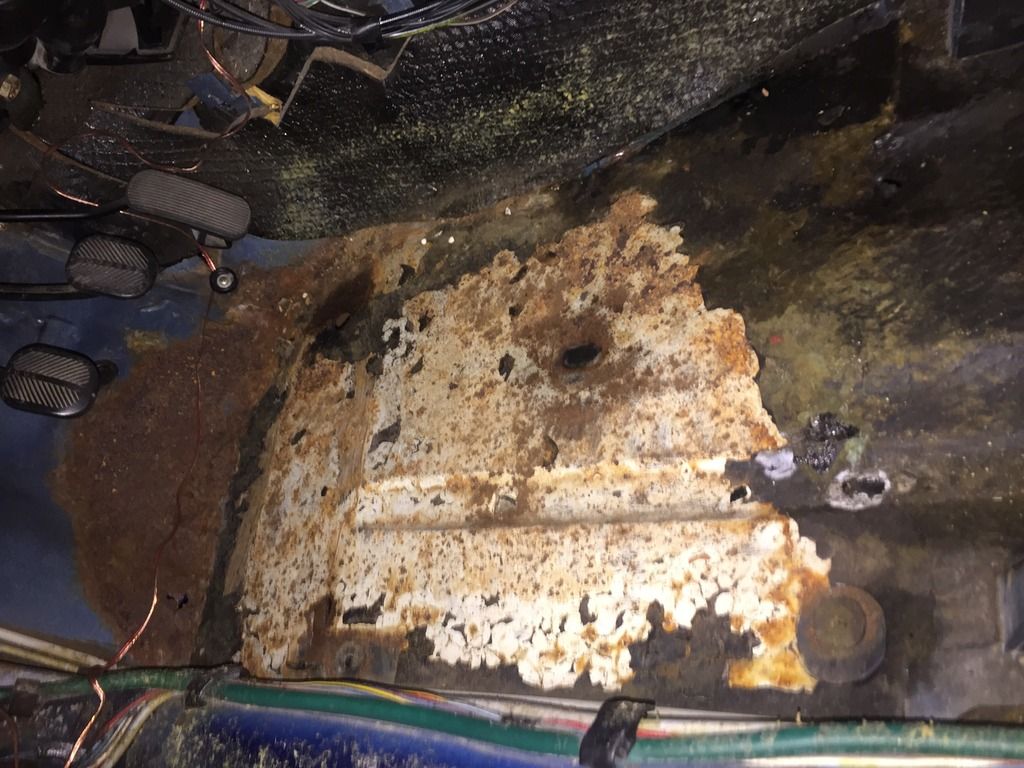
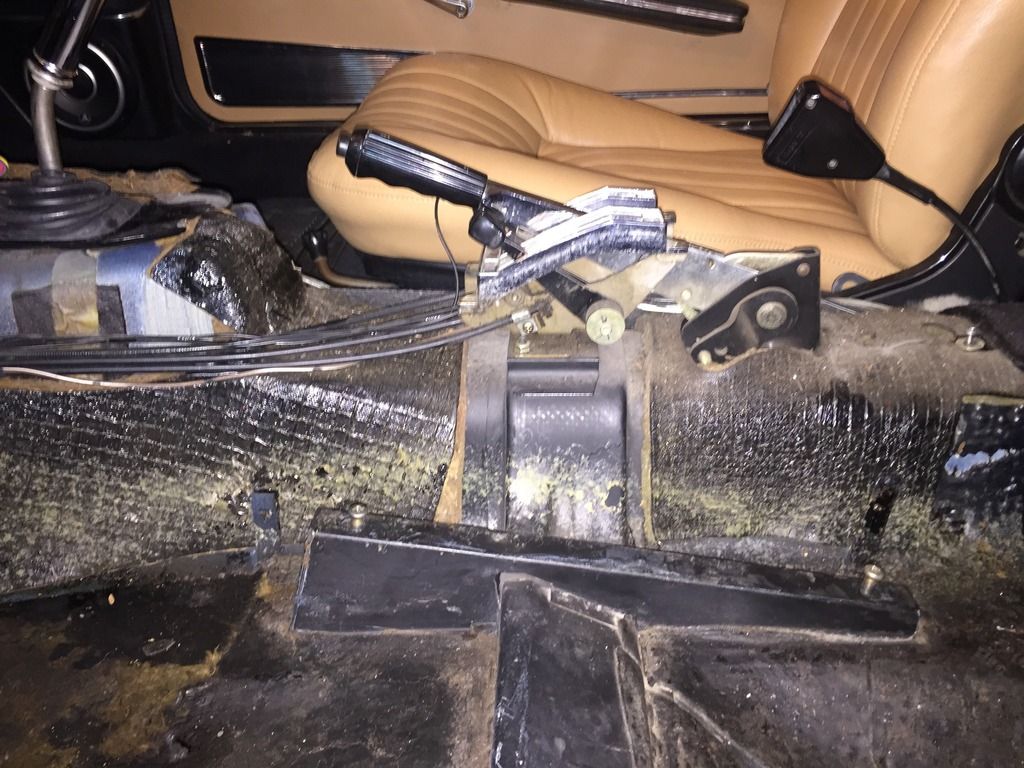
These are the areas that are stuck down really well and required heat. It seems like water didn't get underneath and as a result the floor is in good shape:
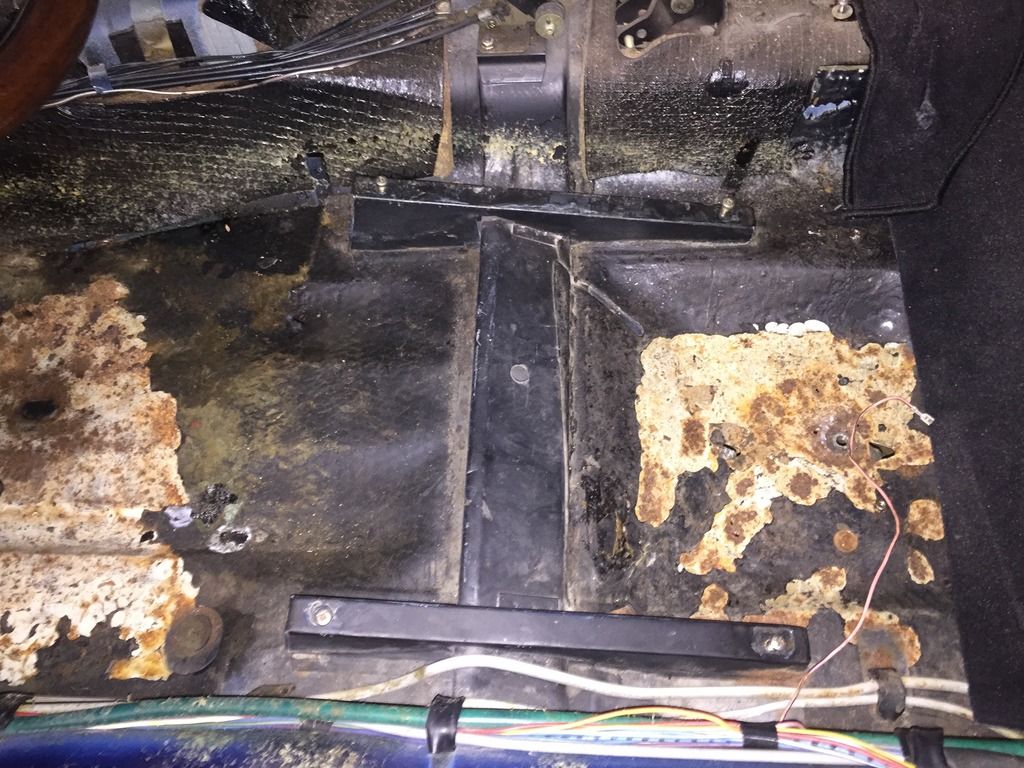
Heat and elbow grease:
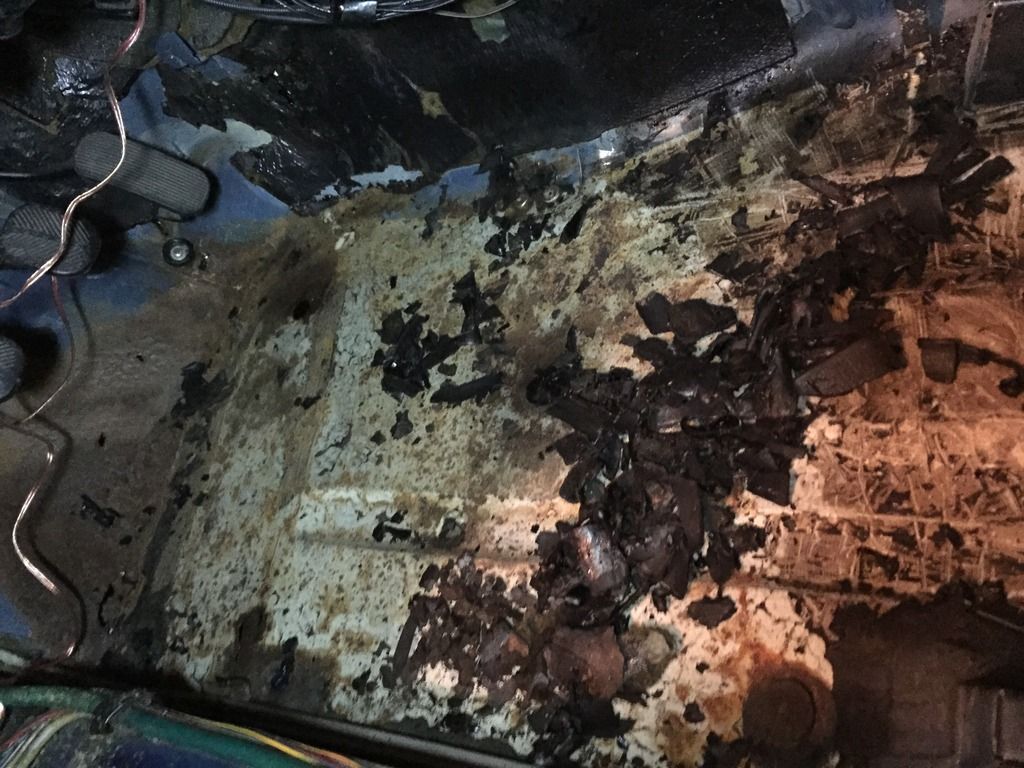


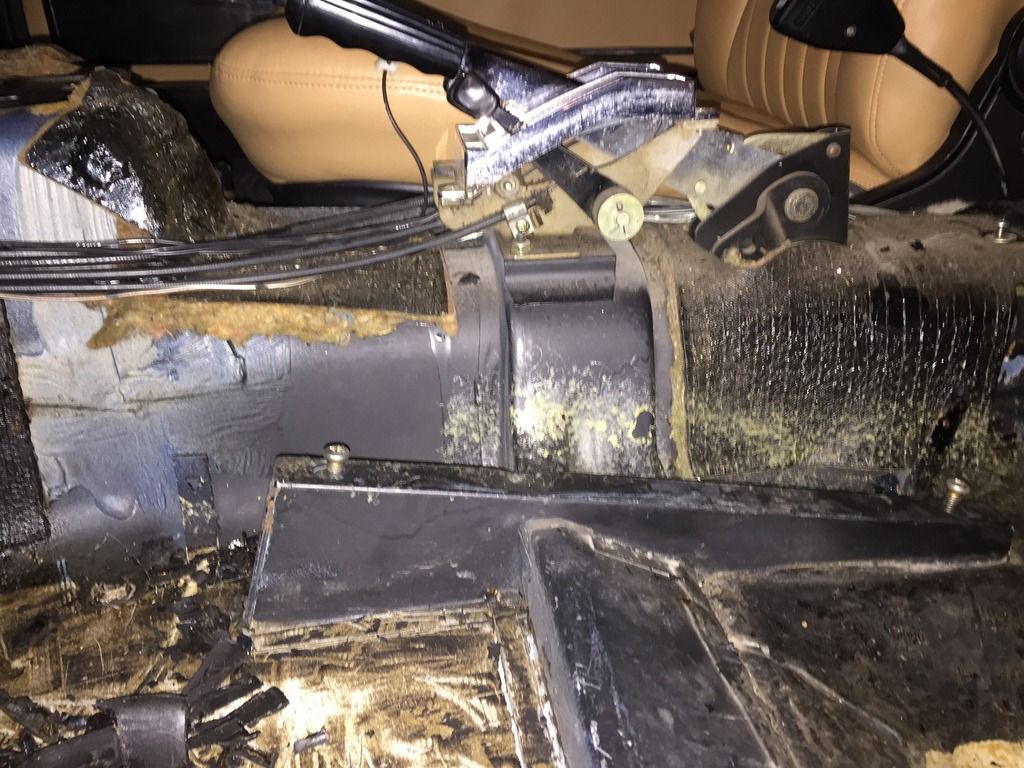
Have to remove the tar from the trans tunnel sides. I removed the rubber plug from the drain hole so it looks like a hole in the middle of the floor:
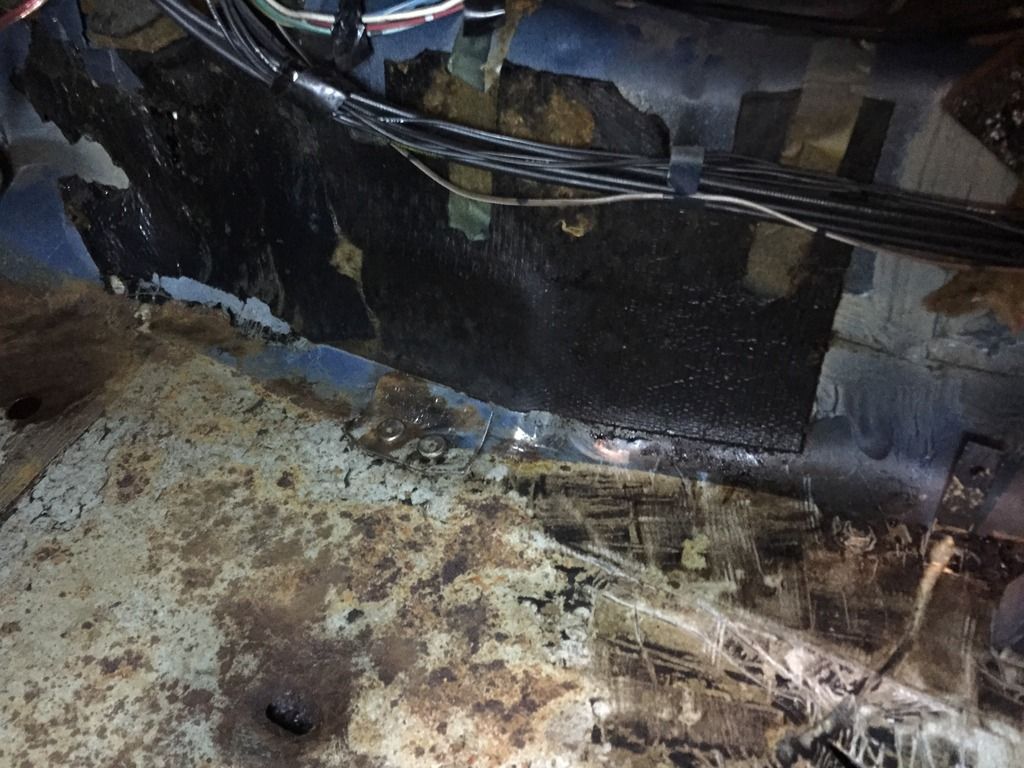

Almost all off. You can see the threaded hole in the rear panel where the belt tensioner bolts in to:

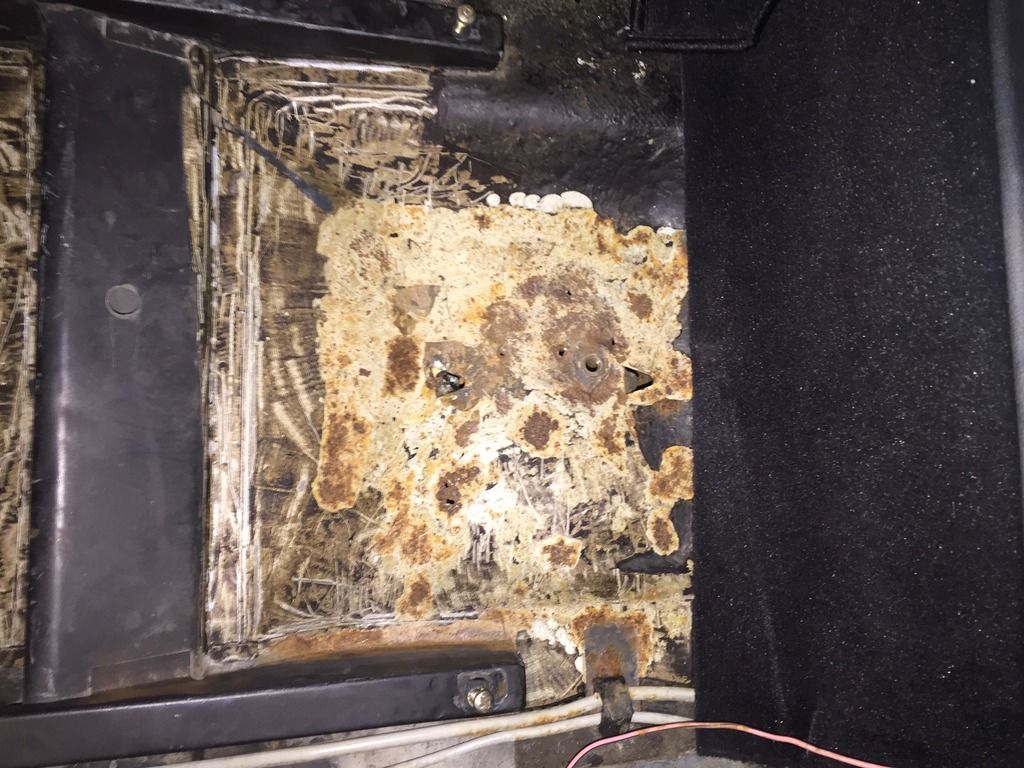
Couple of questions:
Does anybody actually leave this stuff down if its stuck really well? probably not lol
Should I wire brush to bare metal when cleaning the panels up, or just enough to remove the residue and surface rust while leaving the white coating on the panels?
For the footwell area, are there formed panels available or do you guys just cut a piece of sheet metal to size and form it to shape following the contours of the footwell? Depending on how much needs to be cut out...
The areas that were brittle in the forward floor panel chipped away easily with a scrapper and light taps from a hammer. As I got further back the stuff was stuck down real good and required a heat gun to soften it and then a scrapper to peel it up..
ready to pull off the jute and continue scrapping. Looks like the area under the pedals will need to be cut out and patched but the rest of the floor is pretty good:



These are the areas that are stuck down really well and required heat. It seems like water didn't get underneath and as a result the floor is in good shape:

Heat and elbow grease:




Have to remove the tar from the trans tunnel sides. I removed the rubber plug from the drain hole so it looks like a hole in the middle of the floor:


Almost all off. You can see the threaded hole in the rear panel where the belt tensioner bolts in to:


Couple of questions:
Does anybody actually leave this stuff down if its stuck really well? probably not lol
Should I wire brush to bare metal when cleaning the panels up, or just enough to remove the residue and surface rust while leaving the white coating on the panels?
For the footwell area, are there formed panels available or do you guys just cut a piece of sheet metal to size and form it to shape following the contours of the footwell? Depending on how much needs to be cut out...
- RRoller123
- Patron 2020

- Posts: 8179
- Joined: Sun Nov 13, 2011 2:04 pm
- Your car is a: 1980 FI SPIDER 2000
- Location: SAGAMORE BEACH, MA USA
Re: My 1978 Spider progressive restoration
Labor of love, good work. That is a nasty job that no one looks forward to.
Pete
Pete
'80 FI Spider 2000
'74 and '79 X1/9 (past)
'75 BMW R75/6
2011 Chevy Malibu (daily driver)
2010 Chevy Silverado 2500HD Ext Cab 4WD/STD BED
2002 Edgewater 175CC 80HP 4-Stroke Yamaha
2003 Jaguar XK8
2003 Jaguar XKR
2021 Jayco 22RB
2019 Bianchi Torino Bicycle
'74 and '79 X1/9 (past)
'75 BMW R75/6
2011 Chevy Malibu (daily driver)
2010 Chevy Silverado 2500HD Ext Cab 4WD/STD BED
2002 Edgewater 175CC 80HP 4-Stroke Yamaha
2003 Jaguar XK8
2003 Jaguar XKR
2021 Jayco 22RB
2019 Bianchi Torino Bicycle
-
njoconnor
- Posts: 614
- Joined: Thu Jul 05, 2012 7:06 pm
- Your car is a: 1972 124 Spider
Re: My 1978 Spider progressive restoration
Excellent work, Frank, keep going. Your pix bring back memories of chilly weekends a couple of years ago!
Once I was done chipping the coating, I shop vacced the entire area, then wiped it down with Simple Green.Let that dry, then went at it with a rust neutralizer similar to POR. 2 coats of that per instructions, then topped the entire interior tub with rust inhibiting version of Rustoleum primer, then topped that with Rustoleum Marine Blue (close to the car's exterior color). I didn't need to wire brush, so can't address that.
A friend restores cars nearby, and his take on the foot well was "new driver's floor" (but....I could check tire wear on the left front through my foot well....). I had him do it (welding is on the "learn to do" list), and feel better with solid metal all the way back under the seat.
Keep at it. Pretty soon you'll be adding parts back onto the car, instead of taking things off/out.
Neil
Once I was done chipping the coating, I shop vacced the entire area, then wiped it down with Simple Green.Let that dry, then went at it with a rust neutralizer similar to POR. 2 coats of that per instructions, then topped the entire interior tub with rust inhibiting version of Rustoleum primer, then topped that with Rustoleum Marine Blue (close to the car's exterior color). I didn't need to wire brush, so can't address that.
A friend restores cars nearby, and his take on the foot well was "new driver's floor" (but....I could check tire wear on the left front through my foot well....). I had him do it (welding is on the "learn to do" list), and feel better with solid metal all the way back under the seat.
Keep at it. Pretty soon you'll be adding parts back onto the car, instead of taking things off/out.
Neil
Neil O'Connor
Madison, WI
72 FIAT 124 Spider
12 Jeep Grand Cherokee Overland Summit
14 Ram 1500 Laramie Longhorn Eco-Diesel
ex-71 FIAT 124 Coupe
and a host of Audi's, Saabs, VW's, MOPAR's, Fords, and a Bimmer....
Madison, WI
72 FIAT 124 Spider
12 Jeep Grand Cherokee Overland Summit
14 Ram 1500 Laramie Longhorn Eco-Diesel
ex-71 FIAT 124 Coupe
and a host of Audi's, Saabs, VW's, MOPAR's, Fords, and a Bimmer....
-
klweimer
- Posts: 550
- Joined: Tue Mar 27, 2012 7:45 am
- Your car is a: 1982 Spider 2000
- Location: Arvada, Colorado
Re: My 1978 Spider progressive restoration
Frank,
I think a lot of folks try to remove all the old tar, sound or not. I'm doing the same job right now and have taken up everything that looks at all suspicious and left what proved to be solid and well adhered to the body. That said, I live in Colorado and we don't have the moisture and rust problems other parts of the country have. As for the foot well area, I don't think anyone makes a steel repair panel that curves up from the floor to the firewall. I would get in to all the rusty areas with a wire brush on an electric drill and see how bad it is. If the steel isn't completely rusted through, I wouldn't bother with steel patches. If you do some searching on the site, you'll find lots of threads on different repair options. One thing to do for sure is some kind of rust neutralizing treatment, typically with a phosphoric acid product. For what it's worth, you floor really looks pretty good.
Kirk
I think a lot of folks try to remove all the old tar, sound or not. I'm doing the same job right now and have taken up everything that looks at all suspicious and left what proved to be solid and well adhered to the body. That said, I live in Colorado and we don't have the moisture and rust problems other parts of the country have. As for the foot well area, I don't think anyone makes a steel repair panel that curves up from the floor to the firewall. I would get in to all the rusty areas with a wire brush on an electric drill and see how bad it is. If the steel isn't completely rusted through, I wouldn't bother with steel patches. If you do some searching on the site, you'll find lots of threads on different repair options. One thing to do for sure is some kind of rust neutralizing treatment, typically with a phosphoric acid product. For what it's worth, you floor really looks pretty good.
Kirk
-
AriK
- Patron 2018

- Posts: 1148
- Joined: Sat Apr 02, 2011 7:58 pm
- Your car is a: 1979 Fiat Spider
- Location: Montreal Canada
Re: My 1978 Spider progressive restoration
Frank,
Congratulations on your find. That is one beautiful car. It sure looks like a keeper!!
When i performed the floor restoration on my 79, i chipped up all the tar on my floor, i went as far as front and rear floor pans and a straight line half way up the transmission tunnel. It was obvious when i reached the point where the metal under the tar was not affected by rust or moisture, it became really difficult to chip away so i stopped chipping at those points. The floors under my rear seat (beyond the crossmember) were totally solid so i did not chip at that point. It's a big area and i saw no point.
I did sand with a 5" rotary sander and it made all the difference in the world as you can see before/after in the photos below. A P-40 industrial grit was coarse enough for the job (the disks come in a light aqua color). In the after pic one would never know the amount of surface rust that accumulated there in 35 years. Por-15 treatment would be the next step. You may want to go one step further and remove the cushions and do the seat pans as well, heck, you're already there.
Btw, for minor holes you can apply fiberglass cloth and soak it with Por-15, when dry, it will be as hard as the floor itself.
I did not re-apply any new tar sheets, just an aluminum backed auto insulation, nothing pricey. In my opinion, if i ever get any water or coolant infiltration it would be easy to make things right again.
Good luck and keep the patience, you have all the time you need before driving season returns. Once you're done you'll be proud you did it and it's an area you will never need to address again.
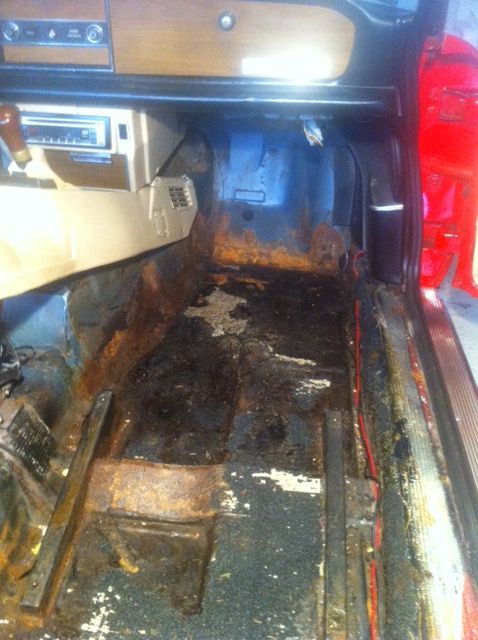
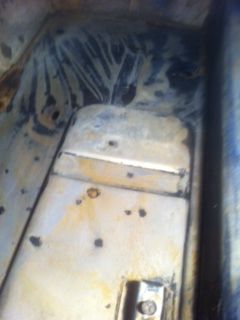
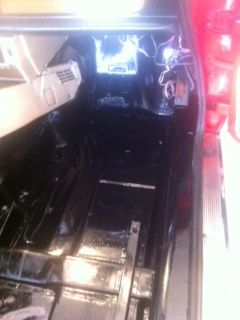
Congratulations on your find. That is one beautiful car. It sure looks like a keeper!!
When i performed the floor restoration on my 79, i chipped up all the tar on my floor, i went as far as front and rear floor pans and a straight line half way up the transmission tunnel. It was obvious when i reached the point where the metal under the tar was not affected by rust or moisture, it became really difficult to chip away so i stopped chipping at those points. The floors under my rear seat (beyond the crossmember) were totally solid so i did not chip at that point. It's a big area and i saw no point.
I did sand with a 5" rotary sander and it made all the difference in the world as you can see before/after in the photos below. A P-40 industrial grit was coarse enough for the job (the disks come in a light aqua color). In the after pic one would never know the amount of surface rust that accumulated there in 35 years. Por-15 treatment would be the next step. You may want to go one step further and remove the cushions and do the seat pans as well, heck, you're already there.
Btw, for minor holes you can apply fiberglass cloth and soak it with Por-15, when dry, it will be as hard as the floor itself.
I did not re-apply any new tar sheets, just an aluminum backed auto insulation, nothing pricey. In my opinion, if i ever get any water or coolant infiltration it would be easy to make things right again.
Good luck and keep the patience, you have all the time you need before driving season returns. Once you're done you'll be proud you did it and it's an area you will never need to address again.



-
Frankd1
- Posts: 135
- Joined: Tue Sep 15, 2015 4:13 pm
- Your car is a: 1978 Spider
- Location: Southwestern Ontario, Canada
Re: My 1978 Spider progressive restoration
Thanks guys, appreciate the tips!
I will look at fiberglass cloth for a couple of the small holes....
I did a little bit today, I tried naval jelly on the pitted areas and the footwell area under the pedals. I left it on for a while and instead of hosing the tub down to rinse, I used a spray bottle with water to get the area wet and then wiped it with a cloth.
I then used the heat gun to dry everything and as I was doing this, the areas where the naval jelly was, started to turn a white-ish color. Is this normal?
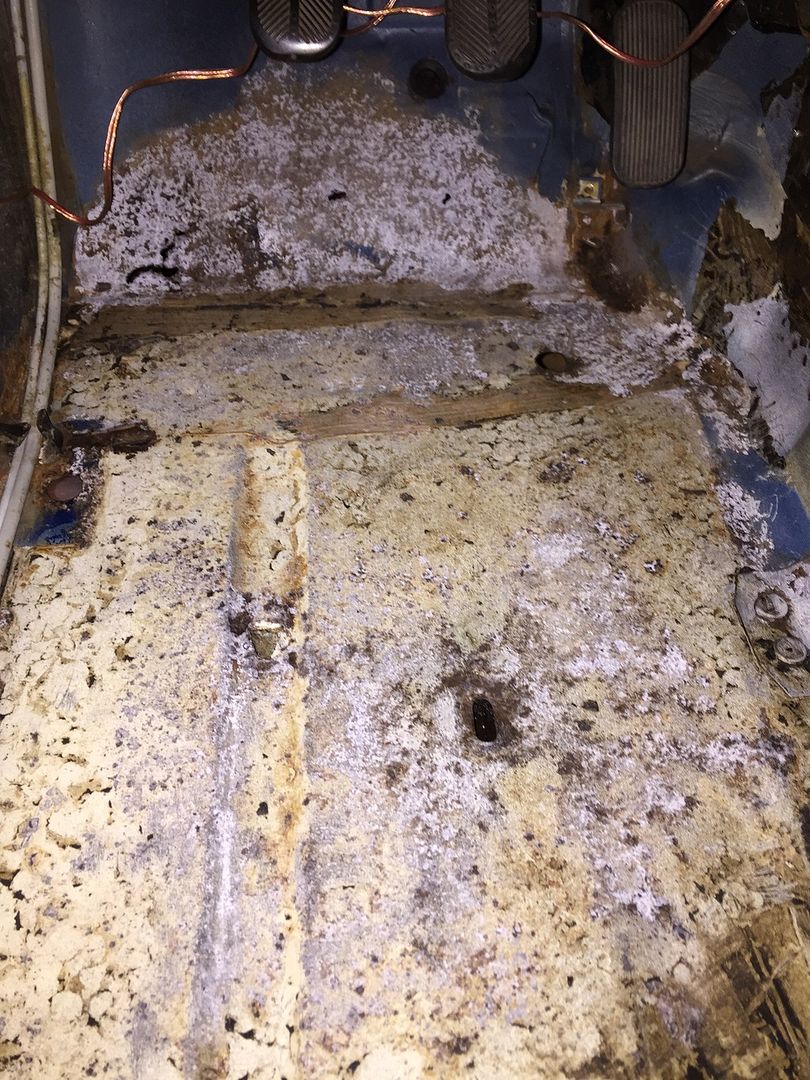
On another note, I think I may replace the fuel lines... Overall they seem pretty good but there are a few areas with some surface corrosion spots.
It will also be easier to clean and sand the floor area under the lines etc..still deciding on this though
I will look at fiberglass cloth for a couple of the small holes....
I did a little bit today, I tried naval jelly on the pitted areas and the footwell area under the pedals. I left it on for a while and instead of hosing the tub down to rinse, I used a spray bottle with water to get the area wet and then wiped it with a cloth.
I then used the heat gun to dry everything and as I was doing this, the areas where the naval jelly was, started to turn a white-ish color. Is this normal?

On another note, I think I may replace the fuel lines... Overall they seem pretty good but there are a few areas with some surface corrosion spots.
It will also be easier to clean and sand the floor area under the lines etc..still deciding on this though
-
AriK
- Patron 2018

- Posts: 1148
- Joined: Sat Apr 02, 2011 7:58 pm
- Your car is a: 1979 Fiat Spider
- Location: Montreal Canada
Re: My 1978 Spider progressive restoration
White residue after use is due to salts and can be removed with water and baking soda.
Google is your friend
The fuel lines don't look so bad, but yes once you're there...project creep...might as well address that especially the clamps that hold them in place and clean up/lube the grommet where the line exits the back floor.
Google is your friend
The fuel lines don't look so bad, but yes once you're there...project creep...might as well address that especially the clamps that hold them in place and clean up/lube the grommet where the line exits the back floor.
-
Frankd1
- Posts: 135
- Joined: Tue Sep 15, 2015 4:13 pm
- Your car is a: 1978 Spider
- Location: Southwestern Ontario, Canada
Re: My 1978 Spider progressive restoration
I wasn't sure if it was ok to leave the residue so I went at it with water, baking soda and a nylon scrub brush and it seemed to do the trick....
Should I spray a light coat of oil on the pan? Something like Boeshield T-9?
I'm thinking from the standpoint of protecting the metal from further oxidation until I can work on it next....
Should I spray a light coat of oil on the pan? Something like Boeshield T-9?
I'm thinking from the standpoint of protecting the metal from further oxidation until I can work on it next....